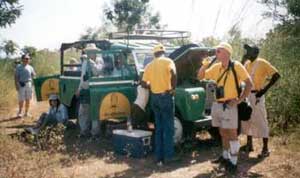Yundum Woods
Time for a new woodland, well, wooded savannah would be more accurate. En route we picked up a Woodland Kingfisher on a telegraph wire plus a nearby Senegal Coucal. The new wood was near Yundum so we named it Yundum Woods. We started with two Dark-chanting Goshawks and eventually saw four of these birds here. The wood also produced our our first Rufous-crowned Roller. Whistling Cisticola was heard and yet another cuckoo found. First identified as either African or Eurasian Cuckoo it avoided us for a bit then flew straight towards us. A few of us had a good view of the front of the bird and we realised it was a Red-chested Cuckoo, a bird we hadn't considered we would see on our trip to The Gambia. This bird is a bit of a rarity here and was a lifer even for Vaughan.

A welcome break with cold drinks
The usual woodland birds were easily found: Bearded Barbet, Green Wood-hoopoe, Fine-spotted Woodpecker, Lizard Buzzard, the doves, plus a wintering Common Redstart. I stopped for a 'call of nature' whilst the others carried on. Whilst busy I noticed some hirundines flying nearby. A quick check with the bins showed them to be new for the trip and indeed my life. I shouted, very loudly I am told, 'Pied-winged Swallow' and gesticulated urgently in the birds direction. Everyone managed to catch up with these birds which was a relief because they were flying in a fast and determined manner and weren't hanging around.
Just after the swallow excitement we came across a Northern Black Flycatcher and I had a small bird with apparently huge tail-streamers. Most confusing until I realised it was a Village Weaver carrying two long grass stems which were perfectly positioned to extend the apparent length of its tail! More common woodland species followed with Senegal Parrot, African Golden Oriole, Yellow-throated Leaflove and Vieillot's Barbet. We also had our first Purple Glossy Starlings, mixing with Greater Blue-eareds in a tree and then a Wahlberg's Eagle was spotted circling overhead. The long tail of this species makes it pretty obvious even from quite a distance. With all eyes on the sky we found a Lanner Falcon shooting overhead followed quickly by another. A couple of Senegal Eremomolas were the next new birds for our list.
We then came across a bees' nest high in a tree. Worth a check it was felt so we staked out both the nest and the surrounding trees. Now things started to hot up and we had a very intense few minutes. We started with Greater Honeyguide heading for the bees' nest, then Cardinal Woodpecker, Singing Cisticola, Common Chiffchaff, Western Bonelli's Warbler, Northern Puffback and Little Weaver! The highlight for some of us was a Black Wood-hoopoe – not black but deep purple and a far nicer-looking bird than is indicated in the guides.
After a few days up-rivr we were back at Yundum since one visit to one place will never give all the species that one might see. We walked a different path to the one taken on our first visit and soon found our second Pygmy Sunbird, another male and a bird, I am told, that is not commonly found on the coast. Grey-headed Sparrows were, of course, around, as was Tawny-flanked Prinia, a Whinchat and two Woodchat Shrikes. More usual savannah woodland species were found: Splendid, Beautiful and Variable Sunbirds, Pin-tailed Whydah, Green Wood-hoopoe, Red-cheeked Cordon-bleu, Little Bee-eater and various doves. We found an open area surrounded by trees and saw a Pearl-spotted Owlet fly into one of the trees. As soon as it landed a nearby tree erupted with Village Weavers who proceeded to mob the poor owl. A little further on we came across feeding and stationary Red-chested and Pied-winged Swallows and Fanti Saw-wings and a sitting Lizard Buzzard. As we watched a Senegal Eremomela the call came of 'Senegal Batis'. We dived for the sound and saw a fine male batis feeding in the open. A few metres to the right the female was also feeding. As we enjoyed these new birds another Black Wood-hoopoe was found, again looking much better than in the books.
More 'common' birds were found: Wahlberg's Eagle, African Harrier-hawk, Brown Babbler, Yellow-billed Shrike, three Green Turacos, Fine-spotted Woodpecker, African Golden Oriole, Northern Black Flycatcher, Blue-bellied and Rufous-crowned Rollers – the list goes on. At one stop we found a weaver nest of unfamiliar design and were soon watching a pair of Vitelline or African Masked Weavers. On the way back we again found the Red-chested Cuckoo, still in the same area as it had been a few days before.
Next we were aiming for a bird we really wanted to see. A short drive and we were walking through a field that had been harvested of its watermelons. In total we found seven Black-headed Lapwings and a few Piapiacs, both of which were easy to see but neither of which were what we were after. Then someone found the first of our target birds and we eventually found four of them: Temminck's Courser. Very hard to see until one gets one's eye in. Of course, if they move and then freeze they disappear again! Some people managed to spend many happy minutes staring at muddy furrows searching for these elusive creatures. But once they were found it was worth the effort and strain! It was also entertaining to watch the photographers amongst us creeping up on the birds and just as they were about to take the picture the birds ran off. This seemed to happen quite a lot! A top ten wanted bird if ever there was one.

